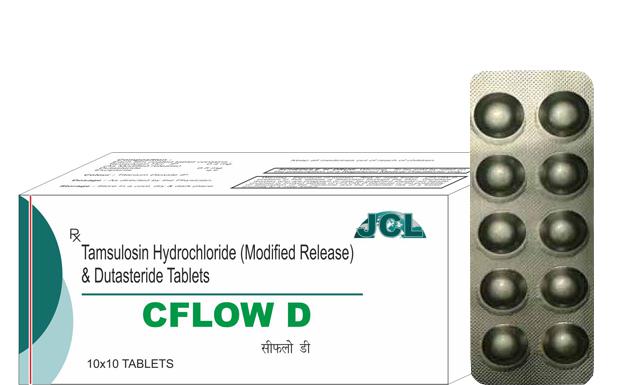Indications:
Dutasteride and tamsulosin hydrochloride are indicated for the treatment of symptomatic BPH in men with an enlarged prostate.
Pharmacology:
Mechanism of Action:
Dutasteride blocks the action of an enzyme called 5-alpha-reductase. This enzyme changes testosterone to another hormone that causes the prostate gland to grow. Dutasteride will cause the size of the prostate to decrease, but the effect lasts only as long as the medicine is taken. If it is stopped, the prostate begins to grow again.
Tamsulosin helps relax the muscles in the prostate gland and the opening of the bladder. This may help increase the flow of urine or decrease symptoms.
Dutasteride:
Dutasteride inhibits the conversion of testosterone to DHT. DHT is the androgen primarily responsible for the initial development and subsequent enlargement of the prostate gland. Testosterone is converted to DHT by the enzyme 5 alpha-reductase, which exists as 2 isoforms, type 1 and type 2. The type 2 isoenzyme is primarily active in the reproductive tissues, while the type 1 isoenzyme is also responsible for testosterone conversion in the skin and liver. Dutasteride is a competitive and specific inhibitor of both type 1 and type 2 5 alpha-reductase isoenzymes, with which it forms a stable enzyme complex. Dissociation from this complex has been evaluated under in vitro and in vivo conditions and is extremely slow.
Tamsulosin:
Smooth muscle tone is mediated by the sympathetic nervous stimulation of alpha1-adrenoceptors, which are abundant in the prostate, prostatic capsule, prostatic urethra, and bladder neck. Blockade of these adrenoceptors can cause smooth muscles in the bladder neck and prostate to relax, resulting in an improvement in urine flow rate and a reduction in symptoms of BPH. Tamsulosin, an alpha1-adrenoceptor blocking agent, exhibits selectivity for alpha1-receptors in the human prostate. At least 3 discrete alpha1-adrenoceptor subtypes have been identified: alpha1A, alpha1B, and alpha1D; their distribution differs between human organs and tissue.
Pharmacokinetics:
Absorption:
Tamsulosin: Absorption of tamsulosin is essentially complete ( > 90%) following oral administration of 0.4-mg tamsulosin hydrochloride capsules under fasting conditions. Tamsulosin exhibits linear kinetics following single and multiple dosing, with achievement of steady-state concentrations by the fifth day of once-daily dosing.
Dutasteride: Administration of a single 0.5-mg dose, time to peak absolute bioavailability is approximately 60% (range: 40% to 94%).
Distribution:
Tamsulosin: Tamsulosin is extensively bound to human plasma proteins (94% to 99%), primarily alpha-1 acid glycoprotein (AAG), with linear binding over a wide concentration range (20 to 600 ng/mL).
Dutasteride: Pharmacokinetic data following single and repeat oral doses show that dutasteride has a large volume of distribution (300 to 500 L). Dutasteride is highly bound to plasma albumin (99.0%) and alpha-1 acidglycoprotein (96.6%).
Metabolism:
Tamsulosin: There is no enantiomeric bioconversion from tamsulosin [R(-) isomer] to the S(+) isomer in humans. Tamsulosin is extensively metabolized by cytochrome P450 enzymes in the liver and less than 10% of the dose is excreted in urine unchanged. However, the pharmacokinetic profile of the metabolites in humans has not been established. Dutasteride: Dutasteride is extensively metabolized in humans. In vitro studies showed that dutasteride is metabolized by the CYP3A4 and CYP3A5 isoenzymes. Both of these isoenzymes produced the 4'-hydroxydutasteride, 6-hydroxydutasteride, and the 6,4'-dihydroxydutasteride metabolites. In addition, the 15-hydroxydutasteride metabolite was formed by CYP3A4.
Excretion:
Tamsulosin: Tamsulosin undergoes restrictive clearance in humans, with a relatively low systemic clearance (2.88 L/hr).
Dutasteride: Dutasteride and its metabolites were excreted mainly in feces. As a percent of dose, there was approximately 5% unchanged dutasteride (approximately 1% to approximately 15%) and 40% as dutasteride-related metabolites (~2% to ~90%).
Drug Interactions:
Some MEDICINES MAY INTERACT with dutasteride/tamsulosin. Tell your health care provider if you are taking any other medicines, especially any of the following:
● Azole antifungals (eg, fluconazole, itraconazole, ketoconazole, posaconazole), cimetidine, fluoxetine, HIV protease inhibitors (eg, ritonavir), macrolide antibiotics (eg, clarithromycin, erythromycin), nefazodone, paroxetine, telithromycin, or terbinafine because they may increase the risk of dutasteride/tamsulosin's side effects.
● Phosphodiesterase type 5 (PDE5) inhibitors (eg, sildenafil) or other medicines that contain alpha-blockers (eg, prazosin) because symptoms of low blood pressure (eg, severe dizziness, light-headedness, fainting) may occur.
● Warfarin because the risk of side effects may be increased.
Side Effects:
Dizziness, lightheadedness, drowsiness, runny/stuffy nose, back pain & cough.
